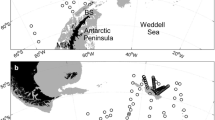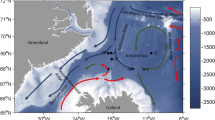Abstract
The abundances of four dominant Antarctic copepod species, Metridia gerlachei, Rhincalanus gigas, Calanoides acutus and Calanus propinquus, were examined in the Southern Ocean in a combination of a literature review, analysis of museum samples and field sampling. The data were analysed for spatial and temporal variations. The data included in the analysis were from the Weddell Sea area in the summertime at periods 1929–1939 and 1989–1993. The results are discussed in the light of environmental changes and their hypothesised and observed consequences in the Southern Ocean: global temperature change, ozone deficiency and cascading trophic interactions. Combining all these hypothetical effects our null hypothesis was that there were no consistent long-term changes in the abundance of dominant pelagic Copepoda. The null hypothesis was rejected, since several taxons did show statistically significant long-term changes in abundance. The changes were not uniform however. The numbers of adults and juveniles of Calanus propinquus increased significantly between the periods studied. Adult stages of Calanoides acutus were the only taxon decreasing in abundance, in concert with the cascading trophic interactions theory. Latitudinally, only Metridia gerlachei showed a significant increase from north to south. Longitudinally, the abundances of Calanus propinquus juveniles and both adults and juveniles of Rhincalanus gigas increased from west to east. There were no significant variations between day and night samples. Interannual changes were statistically significant in juvenile stages of all the species and in adults of Calanus propinquus. We conclude that no uniform and consistent abundance changes could be observed in the pelagic Copepoda of the Weddell Sea that could be connected to major environmental changes, expected to affect the whole planktonic ecosystem of the Southern Ocean. Significant changes in some of the species studied show that the pelagic ecosystem is not in a steady state, but in addition to interannual changes, there are also major fluctuations extending over decades.
Similar content being viewed by others
Author information
Authors and Affiliations
Additional information
Received: 5 December 1996 / Accepted: 24 March 1997
Rights and permissions
About this article
Cite this article
Vuorinen, I., Hänninen, J., Bonsdorff, E. et al. Temporal and spatial variation of dominant pelagic Copepoda (Crustacea) in the Weddell Sea (Southern Ocean) 1929 to 1993. Polar Biol 18, 280–291 (1997). https://doi.org/10.1007/s003000050189
Issue Date:
DOI: https://doi.org/10.1007/s003000050189




